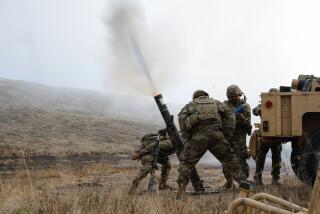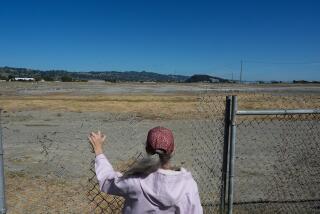Remote Wildlife Refuge Home to Chemical Weapons Incinerator
JOHNSTON ATOLL — This four-island coral atoll 825 miles southwest of Honolulu is a pristine and beautiful place: azure skies, gentle trade winds and crystal blue water teeming with life.
But to visit, you need to carry a gas mask, syringes and antidote.
“Just in case,” a U.S. Army guide explains.
A chemical weapons incinerator operates on this national wildlife refuge. Where marine life and rare tropical birds thrive, the Army destroys millions of pounds of deadly nerve gas, mustard gas and blister agents dating back to World War II.
Can these disparate missions of destruction and survival safely coexist? The Army and the 1,250 people, 80% civilian, who live here believe so.
“I don’t find it ironic. It’s probably the strongest proof that we have that we are not doing anything ecologically damaging on a long-term basis,” says Gary McCloskey, manager of the Army’s Johnston Atoll Chemical Agent Disposal System.
“That’s the reason why we have the seabird and aquatic studies group monitor the project for its duration and to verify that we really are not affecting the wildlife,” he says. “Fear comes from not fully understanding the safeguards that are built into the process.”
In the eight-plus years since the system was built, researchers and U.S. Fish and Wildlife Service scientists say they have no evidence of harm to the marine and bird populations on the four islands--Johnston, Sand, East and North--from the incineration process.
“For eight years now we have been conducting our upwind and downwind studies, and have found no differences in the reproductive success of the red-tailed tropic bird,” the most common bird on the atoll, says Lindsey Hayes, a manager with Fish and Wildlife.
The tropic birds are especially telling since they nest both upwind and downwind of the plant and are very faithful to their nesting sites, returning year after year. This allows Hayes and other scientists to study the same birds and their offspring.
“The populations of all of these birds are growing out here,” he says. “I feel real comfortable saying the plant is having no impact, other than 1,250 people crammed on that island.”
Levels of PCBs have been detected in some fish around Sand Island, but Dr. Philip Lobel, associate professor of biology at Boston University, believes that’s from transformers dumped in the water by the Coast Guard during World War II.
“One of the most sensitive indicators of environmental pollution . . . is the health of the fish. The first indication of poor health is bad reproduction,” Lobel says. “We have not been able to define any effects. This is a beautiful, pristine island. When you get out into these crystal-clear waters, there is incredible coral growth.”
That lack of demonstrated harm to the environment will be touted by the Army as it tries to assure eight U.S. cities that similar weapons incinerators planned for their communities will be safe.
Those communities are Umatilla, Ore.; Tooele, Utah; Pueblo, Colo.; Pine Bluff, Ark.; Newport, Ind.; Anniston, Ala.; Lexington, Ky., and Aberdeen, Md.
“Obviously you can see why anyone would be concerned, but it seems to be working well out here,” Hayes says.
Safety is seen at every level. There’s a 24-hour air monitoring system constantly checking chemical levels, and a control room where workers can shut down operations. Air circulation systems at the incinerator are designed, officials say, to minimize any effects of a leak or explosion.
Video cameras and guards are all around, and double fencing surrounds the plant. No one ever is allowed to enter the weapons area alone, or to be out of sight of a co-worker.
“In a strange sense, it’s almost the safest industry in the world to be involved in because of the level of safety precautions that are built in,” McCloskey says.
Only one person has ever been exposed, he says. That was a soldier “stupidly” carrying a bag of wet munitions over his shoulder, instead of in front of him, according to McCloskey. Mustard agent dripped down his rubber suit and through two unlaced eyelets on his boot, giving the man two coin-size burns on his calf.
The one fatality at JACADS, McCloskey says, occurred on Thanksgiving Day 1997 when a man moving a 1,000-pound piece of metal didn’t realize that it was tipping and it fell on him. “It had nothing to do with chemical agent, it had nothing to do with explosives.”
He adds, joking: “The most dangerous place on this island is the softball field.”
One man who has conquered his initial fears of Johnston is Army Sgt. Charles Putman, now on his third tour of duty at the incinerator.
The chemical ammunitions specialist leads teams of rubber-suited soldiers who transport chemical weapons from 54 concrete, igloo-like storage bunkers to the incinerator. They also check the bunkers for leaky missiles or munitions.
“The first time I walked in here [in 1992], I was almost overwhelmed by my fear,” Putman says. “But as time proceeds you see training, you do training, your confidence grows.”
Putman enjoys the work, even if it means time away from his wife and baby son in Alabama, since no military dependents are allowed to live on the island.
“This is one place I feel I’m doing good,” Putman says. “Getting rid of weapons of mass destruction that can harm people.”
JACADS was built in 1990 and began operating in 1993. When work is completed in fall 2000, the 280,000 chemical weapons stored on the island will have been destroyed. That’s 6.6% of the U.S. chemical weapons arsenal.
So far, 3 million pounds of sarin nerve gas, mustard gas and blister agent have been incinerated. One million pounds remain.
By 2002, the weapons incinerator and all related facilities are scheduled to be taken down. No future military uses are planned for the island, and Hayes and other researchers hope it will remain a wildlife refuge.
That would end a military tradition here dating from World War II, when Johnston was a submarine base and Sand Island was a Coast Guard station.
In the 1950s and ‘60s, the atoll was the site of atmospheric nuclear tests.
Three testing accidents in 1962 left parts of the islands covered with plutonium oxide, and a different team is working on clearing that from the soil, says Air Force Col. Robert Sutton, the man in command of the atoll.
He expects that work to be completed about the same time as the weapons are all incinerated. Meanwhile, people are discouraged from eating fish taken from an area where fallout occurred.
“We probably will never be able to tell you it’s 100% cleaned up, but it will be cleaned to EPA approval,” Sutton says. “I don’t believe there is any hazard there.”
More to Read
Sign up for Essential California
The most important California stories and recommendations in your inbox every morning.
You may occasionally receive promotional content from the Los Angeles Times.










